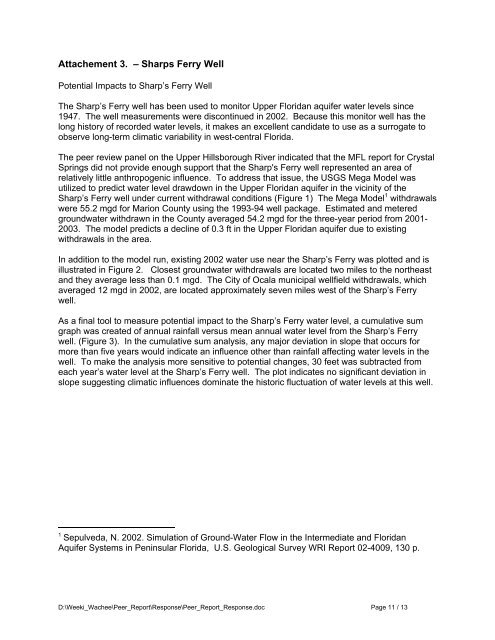Weeki Wachee River System Recommended Minimum Flows and ...
Weeki Wachee River System Recommended Minimum Flows and ...
Weeki Wachee River System Recommended Minimum Flows and ...
You also want an ePaper? Increase the reach of your titles
YUMPU automatically turns print PDFs into web optimized ePapers that Google loves.
Attachement 3. – Sharps Ferry Well<br />
Potential Impacts to Sharp’s Ferry Well<br />
The Sharp’s Ferry well has been used to monitor Upper Floridan aquifer water levels since<br />
1947. The well measurements were discontinued in 2002. Because this monitor well has the<br />
long history of recorded water levels, it makes an excellent c<strong>and</strong>idate to use as a surrogate to<br />
observe long-term climatic variability in west-central Florida.<br />
The peer review panel on the Upper Hillsborough <strong>River</strong> indicated that the MFL report for Crystal<br />
Springs did not provide enough support that the Sharp's Ferry well represented an area of<br />
relatively little anthropogenic influence. To address that issue, the USGS Mega Model was<br />
utilized to predict water level drawdown in the Upper Floridan aquifer in the vicinity of the<br />
Sharp’s Ferry well under current withdrawal conditions (Figure 1) The Mega Model 1 withdrawals<br />
were 55.2 mgd for Marion County using the 1993-94 well package. Estimated <strong>and</strong> metered<br />
groundwater withdrawn in the County averaged 54.2 mgd for the three-year period from 2001-<br />
2003. The model predicts a decline of 0.3 ft in the Upper Floridan aquifer due to existing<br />
withdrawals in the area.<br />
In addition to the model run, existing 2002 water use near the Sharp’s Ferry was plotted <strong>and</strong> is<br />
illustrated in Figure 2. Closest groundwater withdrawals are located two miles to the northeast<br />
<strong>and</strong> they average less than 0.1 mgd. The City of Ocala municipal wellfield withdrawals, which<br />
averaged 12 mgd in 2002, are located approximately seven miles west of the Sharp’s Ferry<br />
well.<br />
As a final tool to measure potential impact to the Sharp’s Ferry water level, a cumulative sum<br />
graph was created of annual rainfall versus mean annual water level from the Sharp’s Ferry<br />
well. (Figure 3). In the cumulative sum analysis, any major deviation in slope that occurs for<br />
more than five years would indicate an influence other than rainfall affecting water levels in the<br />
well. To make the analysis more sensitive to potential changes, 30 feet was subtracted from<br />
each year’s water level at the Sharp’s Ferry well. The plot indicates no significant deviation in<br />
slope suggesting climatic influences dominate the historic fluctuation of water levels at this well.<br />
1 Sepulveda, N. 2002. Simulation of Ground-Water Flow in the Intermediate <strong>and</strong> Floridan<br />
Aquifer <strong>System</strong>s in Peninsular Florida, U.S. Geological Survey WRI Report 02-4009, 130 p.<br />
D:\<strong>Weeki</strong>_<strong>Wachee</strong>\Peer_Report\Response\Peer_Report_Response.doc Page 11 / 13
















